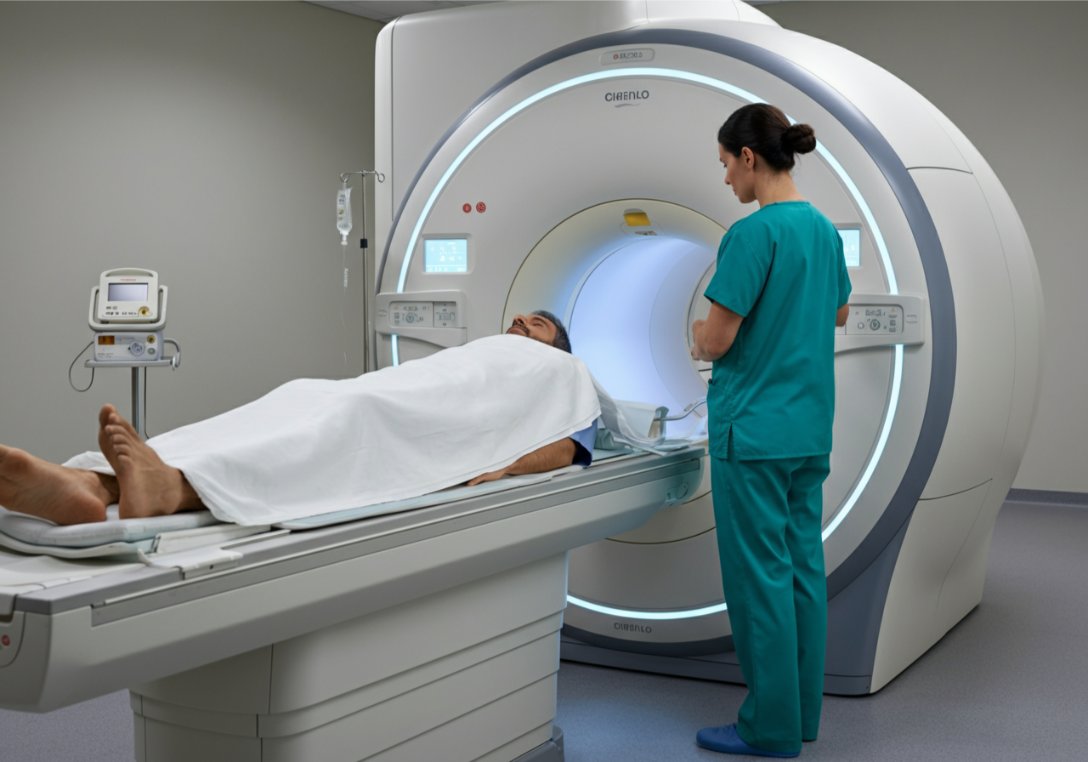Does Your Whole Body Go In for a Liver MRI?
 Written By
Abel Tamirat, MD
Written By
Abel Tamirat, MD

If your doctor has recommended a liver MRI, you may be wondering what exactly happens during the scan. One of the most common questions is: does your whole body go into the MRI machine, or only part of it?
The short answer: most of your body usually goes into the scanner, but the actual images focus only on your liver and nearby organs.
This guide will walk you through everything you need to know about liver MRIs — why they’re done, what they can show, how to prepare, and what to expect before, during, and after the procedure.
Why would you need a liver MRI?
Liver disease is more common than you may think. Research estimates that up to 9.5% of the global population has some form of liver condition. Causes range from alcohol use and hepatitis infections to diabetes and obesity. Sometimes, these same risk factors can also increase the chance of liver cancer.
Your doctor may order a liver MRI if you have:
-
Persistent abdominal pain
-
Jaundice (yellowing of skin or eyes)
-
Fatigue that does not go away
-
Dark urine or pale stools
-
Unexplained weight loss or loss of appetite
-
Swelling in your legs or abdomen
-
Itchy skin
Because MRI provides very clear and detailed images, it is one of the best tools for detecting and monitoring liver conditions early.
Learn how to monitor your liver health with the at-home liver tests guide.
What is a liver MRI?
MRI stands for magnetic resonance imaging. The machine uses a strong magnetic field and radio waves to create detailed pictures of your internal organs. Unlike CT scans or X-rays, it does not involve radiation.
A liver MRI focuses specifically on your liver, but it also shows surrounding structures in your upper abdomen, including:
-
The gallbladder
-
Blood vessels feeding the liver
-
Fat deposits
-
The stomach and pancreas
With its high-contrast images, MRI allows doctors to detect small or subtle changes that other scans might miss.
Because kidney function is often checked alongside liver imaging, explore the kidney function test at home guide.
Does your whole body go into the scanner?

Most of the time, yes. For a liver MRI, your upper body must be positioned in the center of the scanner. Because the scanner is a long tube, this usually means your whole body slides inside.
-
In a closed MRI, you’ll enter headfirst so that your liver is properly aligned. Your arms and legs will also be inside the machine, though they are not being imaged.
-
In an open MRI (available at some centers), there is more space around you, and parts of your body may remain outside the magnet.
Even though it may feel like your entire body is being scanned, the machine only captures images of your liver and the nearby area.
If urinary tract symptoms accompany liver concerns, our UTI tests guide explains testing and prevention.
What can a liver MRI show?
A liver MRI can reveal both structural and functional details of your liver. It helps identify:
-
Liver tumors
-
Metastases
-
Cirrhosis
-
Fatty liver disease
-
Hepatitis
-
Cysts
-
Haemangiomas
-
Focal nodular hyperplasia
-
Hepatocellular carcinoma
-
Bile duct blockages
This scan can also highlight subtle differences between healthy tissue and diseased tissue, which is why it is so useful for early cancer detection.
Since blood sugar management impacts fatty liver disease risk, see understanding high glucose in urine.
What does liver inflammation feel like?

If your liver is inflamed, you might experience:
-
Ongoing fatigue
-
Feeling full quickly after eating
-
Nausea or vomiting
-
Abdominal discomfort (dull ache or stabbing pain under your right ribs)
-
Jaundice
These symptoms should not be ignored. If you notice them together, contact your doctor promptly. A liver MRI may help confirm the cause.
How do you prepare for a liver MRI?
Preparation is simple but important.
-
Fasting: You may be asked not to eat or drink for about 4 hours before the scan.
-
Questionnaire: On arrival, you’ll complete a safety form about your medical history and any implants.
-
Allergies: Tell the staff if you are allergic to medications or contrast dyes.
-
Pregnancy: Always inform the team if you are pregnant or think you might be.
-
Implants: Let them know if you have a pacemaker, defibrillator, stent, joint replacement, or metal fragments in your body.
-
Clothing: You’ll usually change into a gown and remove all jewelry, watches, belts, and anything metallic.
The magnet can affect pacemakers and other devices, so honesty on the questionnaire is vital.
What happens during the scan?
Here’s a step-by-step look at what to expect:
-
Change clothes: You’ll put on a hospital gown and remove all metal objects.
-
Lie on the table: You’ll lie on your back with your head entering the scanner first.
-
Abdominal coil: A cushioned coil may be placed around your stomach to improve image quality.
-
Contrast injection: Some liver MRIs require a contrast dye injected into a vein in your arm. This highlights blood flow and makes details clearer.
-
Instructions: You’ll be given earplugs or headphones because the machine makes loud tapping and knocking noises. You’ll also have an intercom to speak with the radiographer.
-
Breathing cues: At times, you’ll be asked to hold your breath for a few seconds while images are taken.
-
The scan itself: The table slides into the scanner, and the machine collects detailed images.
The whole process usually takes 10–30 minutes. If contrast is used, it may take slightly longer.
For routine monitoring at home, the Ribbon Checkup urine test helps track multiple health indicators.
Is the procedure safe?
MRI is considered very safe. It avoids radiation and can be used for most patients. However, there are some risks and considerations:
-
Claustrophobia: Being inside the scanner can feel confined. A sedative may be offered if needed.
-
Implants and metal: Certain implants can be affected by the magnet.
-
Allergy to contrast dye: Rare but possible. Symptoms can include flushing, shortness of breath, or a metallic taste in the mouth. Staff monitor you closely during and after the scan.
What happens after the scan?
-
If you had contrast dye, you may wait about 30 minutes in case of a reaction.
-
Otherwise, you can change back into your clothes and go about your day.
-
Drink extra water to help flush the dye if you received it.
The radiographer sends your images to a radiologist, who reviews them. Your doctor will then explain the results and may recommend further tests, such as magnetic resonance elastography (MRE) to check liver stiffness.
Benefits of a liver MRI

-
Quick and painless
-
No radiation exposure
-
Very detailed images
-
Useful for diagnosing a wide range of liver diseases
-
Helps detect liver cancer early
Key takeaway
For a liver MRI, most of your body will go into the scanner, but the images focus only on your liver and nearby organs. The scan is safe, highly detailed, and plays a key role in diagnosing liver disease early.
If you’re worried about claustrophobia, implants, or contrast dye, discuss these with your medical team beforehand. With the right preparation, the procedure is smooth and gives your doctor vital information about your liver health.
Between scans, you can still stay proactive. Monitor your liver wellness with the Ribbon Checkup At-Home Liver Test.
References
-
Ezra. (2025, January). Liver MRI: What you need to know. Ezra. https://ezra.com/blog/liver-mri
-
Healthline. (n.d.). MRI of the liver: Uses, accuracy, procedure, and more. Healthline. https://www.healthline.com/health/mri-liver
-
Mayo Clinic. (n.d.). Magnetic resonance elastography. Mayo Clinic. https://www.mayoclinic.org/tests-procedures/magnetic-resonance-elastography/about/pac-20385177
-
National Center for Biotechnology Information. (2023). Magnetic resonance imaging contraindications. In StatPearls. U.S. National Library of Medicine. https://www.ncbi.nlm.nih.gov/books/NBK551669/
-
Pediatric Radiology. (2025, September). Best practices for pediatric liver MRI: Guidelines from international consensus. Springer. https://link.springer.com/article/10.1007/s00247-025-06383-3
-
Radiological Society of North America. (2015). A practical guide to MR imaging safety: What radiologists should know. RadioGraphics, 35(6), 1722–1737. https://pubs.rsna.org/doi/abs/10.1148/rg.2015150108
-
Scan.com. (2025, July 11). Body parts: Liver MRI. Scan.com (UK). https://uk.scan.com/body-parts/mri/liver
-
ScienceDirect. (2023). Patient safety in magnetic resonance imaging. Elsevier. https://www.sciencedirect.com/science/article/abs/pii/S217351072300099X
-
U.S. National Library of Medicine. (2021). Implementation of magnetic resonance safety program for hospitals. PMC. https://pmc.ncbi.nlm.nih.gov/articles/PMC10243289/
-
Hartford Hospital. (n.d.). MRI – Liver factsheet. Hartford HealthCare. https://hartfordhospital.org/File%20Library/Unassigned/ImagingFactsSheet_MRI-Liver.pdf

Dr. Abel Tamirat is a licensed General Practitioner and ECFMG-certified international medical graduate with over three years of experience supporting U.S.-based telehealth and primary care practices. As a freelance medical writer and Virtual Clinical Support Specialist, he blends frontline clinical expertise with a passion for health technology and evidence-based content. He is also a contributor to Continuing Medical Education (CME) programs.



